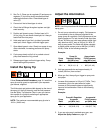
Installation
8 3A0732J
Wall Mount Packages
1. Be sure the wall can support the weight of the
pump, bracket, hoses and accessories, as well as
the stress caused during operation.
2. Position the wall bracket at a convenient height. Do
not stretch the suction hose tight; let it hang to assist
fluid flow into the pump. For ease of operation and
service, make sure the pump air inlet, fluid inlet, and
fluid outlet ports are easily accessible.
3. Using the wall bracket as a template, drill mounting
holes in the wall. Hole diameters and wall mounting
dimensions are shown on page 40.
4. Attach the bracket to the wall. Use screws that are
long enough to keep the pump from vibrating during
operation.
NOTE: Be sure the bracket is level.
Grounding
1. Pump: See F
IG
. 1. Verify that the ground wire (26)
is attached to the ground screw (23), and the screw
is tightened securely to the adapter plate (10). Use
any of the three threaded holes in the adapter plate.
Connect the other end of the ground wire to a true
earth ground.
2. Air and fluid hoses: Static electricity may build up
when fluids flow through pumps, hoses, and spray-
ers. At least one hose must be electrically conduc-
tive, with a maximum of 500 ft. (150 m) combined
hose length to ensure grounding continuity. Check
electrical resistance of hoses. If total resistance to
ground exceeds 25 megohms, replace hose imme-
diately.
3. Air compressor: follow manufacturer's recommen-
dations.
4. Spray gun: ground through connection to a prop-
erly grounded fluid hose and pump.
5. Fluid supply container: follow your local code.
6. Object being sprayed: follow your local code.
7. Solvent pails used when flushing: follow your
local code. Use only metal pails, which are conduc-
tive, placed on a grounded surface. Do not place the
pail on a nonconductive surface, such as paper or
cardboard, which interrupts the grounding continu-
ity.
8. To maintain grounding continuity when flushing or
relieving pressure, hold a metal part of the spray
gun firmly to the side of a grounded metal pail, then
trigger the gun.
Flush Before Using Equipment
The equipment was tested with lightweight oil, which is
left in the fluid passages to protect parts. To avoid con-
taminating your fluid with oil, flush the equipment with a
compatible solvent before using the equipment. See
Prime the Pump, page 10.
The equipment must be grounded. Grounding
reduces the risk of static and electric shock by
providing an escape wire for the electrical current
due to static build up or in the event of a short circuit.
F
IG
. 1. Ground Wire
23
26
ti16282a
10


















